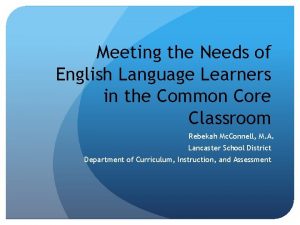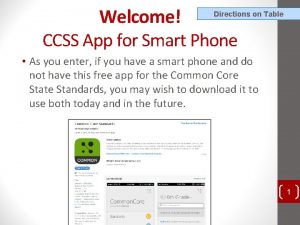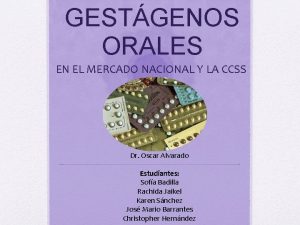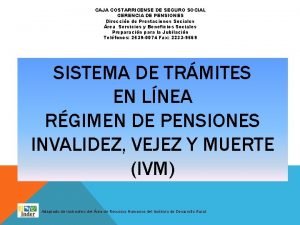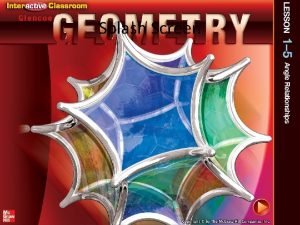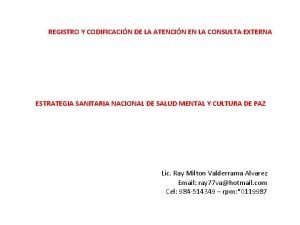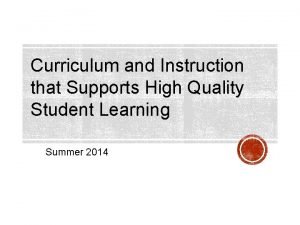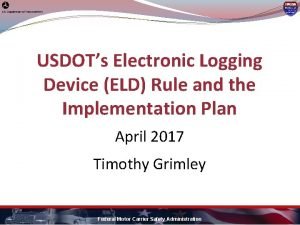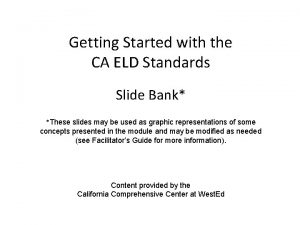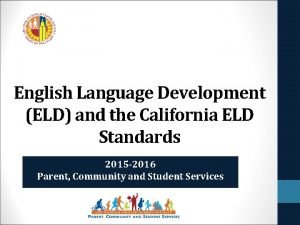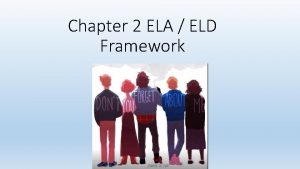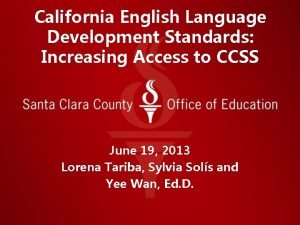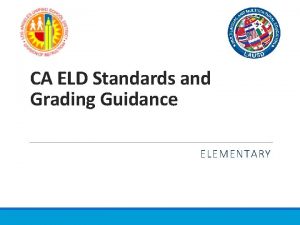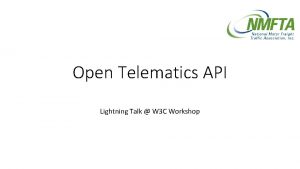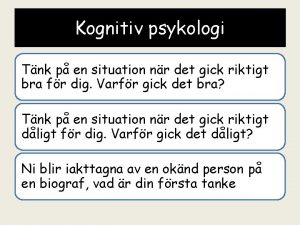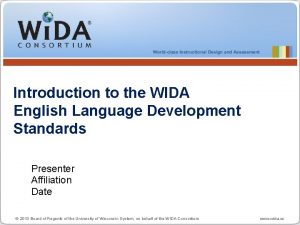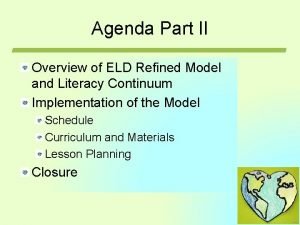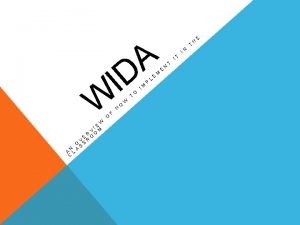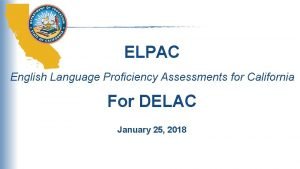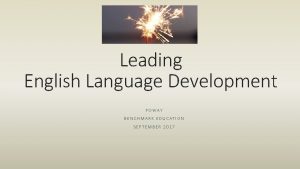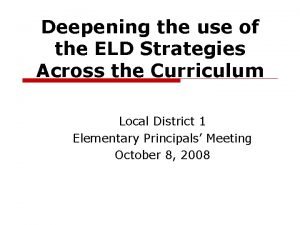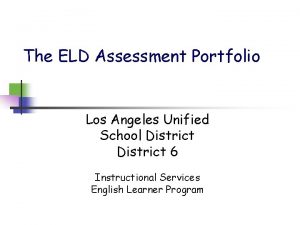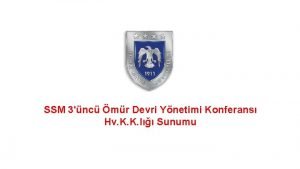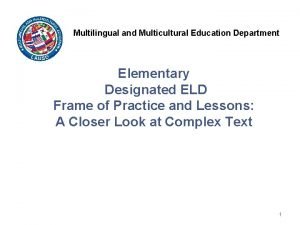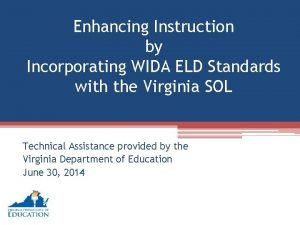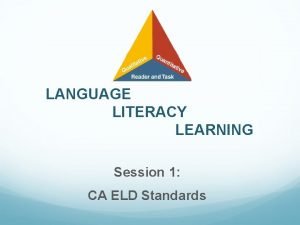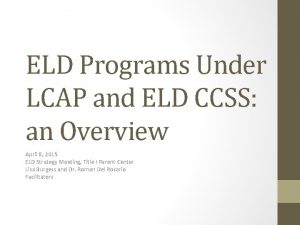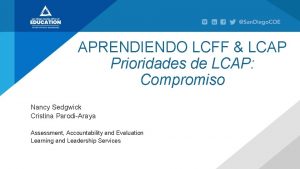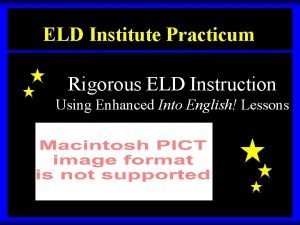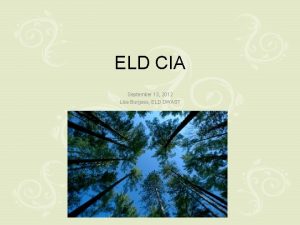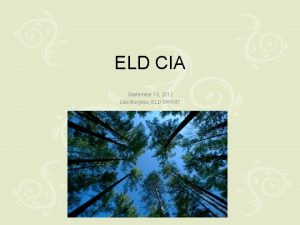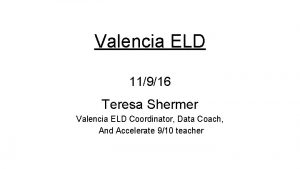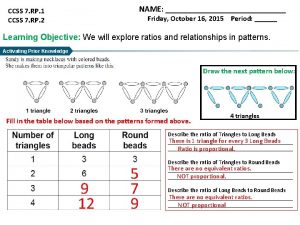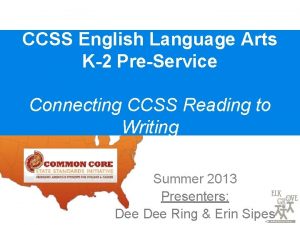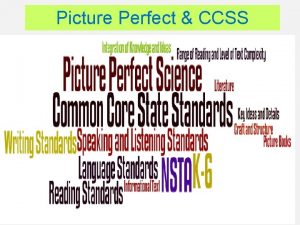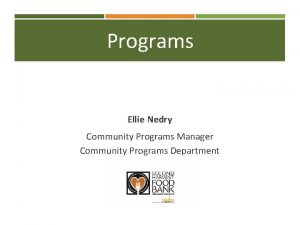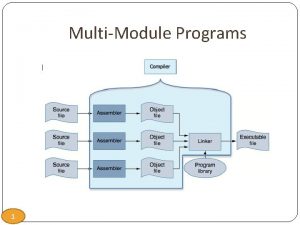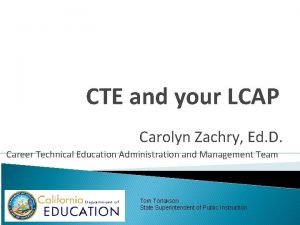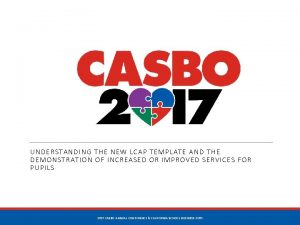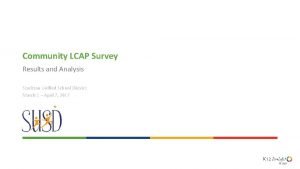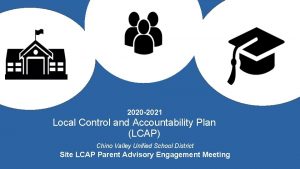ELD Programs Under LCAP and ELD CCSS an





























- Slides: 29

ELD Programs Under LCAP and ELD CCSS: an Overview April 8, 2015 ELD Strategy Meeting, Title I Parent Center Lisa Burgess and Dr. Roman Del Rosario Facilitators

Objectives • Today, we will address needed changes for our ELD Program for the 2015 -2016 School Year: • District-wide ELD Program: • Learn of and understand funding changes under LCAP • Read and Discuss SUHSD EL Program Goals and Action Steps in our District LCAP • Read and Analyze other large school district’s ELD Portions of the EL Master Plans • Suggest ELD Program Plan Changes that will align our ELD Program Course Outlines/Offerings, Curriculum, Instruction and Assessments with LCAP, ELA/ELD Frameworks and ELD CCSS. • District-Wide Internal Formative Assessments for EL Progress monitoring • Read and Discuss ELA/ELD Frameworks Assessment Chapter 8 • Read and Comment on SUHSD Internal Formative Assessment Draft

What Our SUHSD LCAP Says • The Local Control and Accountability Plan (LCAP) and annual update template shall be used to provide details regarding local educational agencies’ (LEAs) actions and expenditures to support pupil outcomes and overall performance pursuant to Education Code sections 52060, 52066, 47605. 5, and 47606. 5. • For school districts, pursuant to Education Code section 52060, the LCAP must describe, for the school district and each school within the district, goals and specific actions to achieve those goals for all pupils and each subgroup of pupils identified in Education Code section 52052, including pupils with disabilities, for each of the state priorities and any locally identified priorities.

SUHSD LCAP Intent • Sweetwater Union High School District (SUHSD) strives to have all students achieve college and career readiness addressing 21 st Century skills infused in technology. As a diverse school district with a number of challenges, we have the need to focus on quality of instruction and on the equity of education for all. • We are committed to provide a district-wide vision that protects high expectations for all, while supporting the needs of the individual. • In addition, our journey is guided to empower professional learning communities to implement curriculum, instruction and assessment at each classroom level that is aligned with the Common Core State standards and to our district common language that embraces lesson planning with defined learning targets, academic language development and evaluation of the learning to promote changes in the instructional delivery.

Questions Addressed in LCAP: • What are the LEA’s goal(s) to address state priorities related to “Conditions of Learning”? • What are the LEA’s goal(s) to address state priorities related to “Pupil Outcomes”? • What are the LEA’s goal(s) to address state priorities related to “Engagement” (e. g. , pupil and parent)? • What are the unique goals for subgroups as defined in Education Code sections 42238. 01 and 52052 that are different from the LEA’s goals for all pupils?

2014 -2015 Specifics: Targeted Group Assessments Technology All English Learners 1. 3 District-wide assessments will be created and implemented at all schools (core only) to support A -G course completion and monitoring. pg. 7 1. 10 EL students will achieve proficiency as measured by the CELDT at a rate that meets or exceeds the state target of 59% Pg. 8 2. 1 All students (grade 7, 8, 9) will improve their proficiency in analyzing and synthesizing information from multiple sources in their core content classes through the use of mobile devices such as IPADS or tablets. Pg. 9 2. 3 Students (grade 7, 8, 9) will have access to the internet, online assessments, Canvas LMS, and school-based applications and e -textbooks throughout the school day due to updated and robust wireless infrastructure at all school campuses. pg. 10 Notes ELD 1 -8 Hr. 1 is Core ELD 1 -8 is Core

2014 -2015 Specifics: Targeted Group Assessments All English Learners 4. 2 District-wide assessments will be created, implemented and monitored at all schools to support course completion in Math, English, Science and Social Science pg. 12. Notes ELD 1 -8 Hr. 1 is Core(ELA/ELD CCSS) Assessments 5. 1 Students will improve by 5% on district-wide assessments: i. e. , Performance Based Tasks Final Exams SBAC interim benchmark tools. Pg. 13

2014 -2015 Specifics: Targeted Group Courses All English Learners 1. 1. 3 District will expand course offerings in a comprehensive summer school program in all core courses to provide A-G course work opportunities for all students. Pg. 16 1. 1. 4 Students not meeting the required level of standards mastery in core content courses will participate in a credit recovery program. Pg. 17 1. 1. 11 Students will be able to recover A-G course credit during the academic year and summer to better access graduation credits. Pg. 17 1. 1. 12 Dual Language and/or Bilingual programs will be implemented based on need and interest for students in the district to support content mastery. ELD 1 -8 Hr. 1 is Core ELD 1 -8, Hr. 1 is Core Notes 1. 1. 13 English Learner students are appropriately placed in core courses. Pg. 17 ELD 1 -8, Hr. 1 is Core

2014 -2015 Specifics: Targeted Group Technology Courses All English Learners 2. 1. 1 SUHSD will provide on-site professional development involving teachers as learners with a focus on the following: Co-planning of Common Core, NGSS and ELD standards on a weekly basis in Professional Learning Communities. Pg. 18 1. 1. 4 Students not meeting the required level of standards mastery in core content courses will participate in a credit recovery program. Pg. 17 1. 1. 11 Students will be able to recover AG course credit during the academic year and summer to better access graduation credits. Pg. 17 1. 1. 12 Dual Language and/or Bilingual programs will be implemented based on need and interest for students in the district to support content mastery. Canvas Page for All Teachers ELD 1 -8, Hr. 1 is Core Notes 1. 1. 13 English Learner students are appropriately placed in core courses. Pg. 17 ELD 1 -8, Hr. 1 is Core

Pgs. 24 -25 EL Specific Actions and Services(Goals) • For English Learners: • District and Site Curriculum/Professional Development specialists will improve instruction for English Learner students through professional development with all core teachers by providing ELD standards and effective EL instructional strategy. • ELD/SEI Teachers on Special Assignment will improve instruction for English Learner students through professional development with all core teachers by providing effective ELD standards and SEI training for all core content area teachers. • An Avid Coordinator will recruit EL students for participation in AVID programs and services. (identified sites) • Bilingual and Dual Language programs will be implemented to support content mastery for EL students. • • • Class sizes will be reduced to ensure students have improved access to content and support in all core areas. students and parents ELD Students ability to recover course credit during the academic year and summer will allow better access to students to obtain graduation credits. • Supplemental IPAD applications for EL students will be utilized in ELD courses to support language acquisition and content mastery in all core content. • English Learner high school students not meeting the CAHSEE will have targeted intervention and support. (high school only) • A comprehensive network of support will be provided to all district schools by the Office of State and Federal Programs to monitor, track, evaluate, support and intervene on behalf of EL, Foster Youth, Low Income, and Reclassified Fluent English Proficient (RFEP). • ELD/SEI Resource Teachers – An English Language Development (ELD) Teacher on Special Assignment will improve instruction for English Learner students by providing effective ELD standards training to core teachers. The emphasis will be targeted methodologies in which English Learners learn English through structured and sequential lessons. Structured English Immersion (SEI) Teachers on Special Assignment will analyze performance data to provide recommendations to school sites for proper program placement of English Learners, monitor placement, and provide professional development and support to Structures English Immersion (SEI) teachers in core content classes. •

Title III Funding is used to: • Supplement Instruction for For Limited English Proficient Students, to achieve standards. • Increase English Proficiency and core academic content knowledge • Not for CORE classes(ELA/ELD)

LAUSD Demographics

LAUSD Demographics


LAUSD EL Plan • LAUSD recognizes its obligation to ensure that ELs become proficient in English as rapidly and effectively as possible. LAUSD considers these obligations to be among the highest priorities of the District. This section describes the ways that ELD is delivered in LAUSD. • WHAT IS ENGLISH LANGUAGE DEVELOPMENT? ELD is a component of all program options for ELs. ELD is separate from but complementary to English-language arts instruction. English-language arts addresses all four domains of language: speaking, listening, reading and writing. It is the content area where students first learn to read, and then read to learn. The intent of ELD is to accelerate English language learning in strategic ways by developing listening, speaking, reading and writing with robust and contextualized instruction. This includes many opportunities for students to engage in meaningful language practices at an appropriate level of challenge and complexity. • Effective ELD improves access to reading/language arts and all core subjects by explicitly focusing on the language demands of the core. It does not replace a robust grade level appropriate reading/language arts program. • It is instruction in addition to a standards-based program in reading and language arts. ELD is considered by the state of California and the U. S. Department of Education to be core instruction for ELs and not an elective or an instructional service from which students may opt out. As described in Improving Education for English Learners: Research-Based Approaches (CDE, 2010), the purpose of ELD instruction is “to advance English learners’ knowledge and use of English in increasingly sophisticated ways. ”

LAUSD EL Plan (Cont’d) • The intent of the ELD component of instructional programs for ELs is for teachers to explicitly and intentionally teach English in order to develop a strong English language foundation in both social and academic settings. • Current research evidence indicates that providing explicit ELD instruction is valuable for ELs. In addition, there is strong supporting evidence that ELD instruction should include interactive activities among students. These activities must be carefully planned and implemented. ELD instruction focuses on all components of the English language is not likely to be acquired adequately or efficiently in other instructional or social settings such as sheltered content classrooms, mainstream English instruction settings, and in daily school, family and community interactions. ELD instruction is research and standards-based. • It is systematically planned and structured via a scope and sequence of language progressions. It must be assessed and monitored for progress over time to ensure that ELs learn English within a reasonable amount of time. • It is planned and delivered targeting specific language objectives. • ELD instruction in LAUSD explicitly teaches elements and features of the English language such as vocabulary, syntax, grammar, discourse, functions and conventions, as well as the comprehension and production of discipline-specific academic language (e. g. , from math, science, social studies)

LAUSD Model

LAUSD ELD Instruction • LAUSD endorses the following guidelines for effective ELD instruction provided by Saunders and Goldenberg (in CDE, 2010, pp. 27 -28): • A separate block of time is devoted to daily ELD instruction. • ELD instruction emphasizes listening and speaking although it can incorporate reading and writing. ELD instruction explicitly teaches elements of English (e. g. , vocabulary, syntax, grammar, functions and conventions). • ELD instruction is planned and delivered with specific language objectives for each lesson. • ELD instruction integrates meaning and communication to support explicit teaching of language. • ELD instruction includes carefully planned interactive activities among students. • ELD instruction provides students with corrective feedback on form. • ELD teachers attend to communication and language-learning strategies during instruction. • ELD instruction emphasizes academic language as well as conversational language. • ELD instruction continues until students meet reclassification criteria. • ELs are carefully grouped by language proficiency for ELD instruction; they are in mixed classrooms, not segregated by language proficiency at other times of the school day. (In LAUSD, appropriate student grouping is described in the section titled ELD Instructional Grouping for Elementary Schools and ELD Instructional Grouping and Course Progression for Middle and High Schools).

How LAUSD Supplements ELD Hour at Middle School: • Middle school ELs who are not yet proficient in English and also read at the 3 rd grade level or lower will be placed in Academic Literacy for English Learners, a literacy intervention course with an additional language development component. The difference between this course and Advanced ELD (below) is the amount of focus and time spent on language development, especially oral language development. • Academic Literacy for English Learners is delivered at a pace that respects the greater maturity of middle school students and does not offer tasks unrelated to the core curriculum or teach discrete grammar skills out of context (e. g. , memorizing syllable types or diagramming sentences). • This course makes use of discipline specific materials that support core classes at an accessible reading level for students so that language and literacy development directly support the students’ skill development in content area classes. • It also incorporates daily practice in developing oral and written academic discourse through carefully planned and implemented interactive activities. The Academic Literacy teacher maintains contact with all the students’ core content teachers and regularly monitors their progress in those classes.

How LAUSD Supplements ELD Hour at High School: • PROGRESSING THROUGH THE ELD COURSE SEQUENCE IN HIGH SCHOOL • Placement of high school ELs follows the process previously described. The expectation is that students will progress through the courses in sequence by mastering the learning objectives of each course and demonstrating mastery through a common final assessment used throughout the District for each ELD course. • With the exception of the Newcomer Program, ELD courses do not replace core English classes. Therefore, high school EL students are to be concurrently enrolled in sheltered/SDAIE or Mainstream English classes and ELD classes; they receive elective credit for ELD courses. • In addition, students will not be required to repeat any ELD course if they score proficient on the common final assessment for that course, even if the students have not received a passing grade. • However, students may choose to repeat an ELD course if they wish to improve a failing grade. • Also, students may challenge their ELD placement by taking the common final assessment for that course. • If the student scores proficient on the assessment, he or she is allowed to move to the next course in the sequence or move into an advanced ELD course if such course is appropriate.

FUSD Demographics

FUSD

FUSD Progress Monitoring Model

SDUSD Demographics

SDUSD Newcomers Core Course

ESL Literacy Block Course Objective, SDUSD

SDUSD ELD Course of Study

Sweetwater Demographics

SUHSD ELD Sequence
 Integrated eld vs designated eld
Integrated eld vs designated eld Ccss app
Ccss app Medroxiprogesterina
Medroxiprogesterina Organigrama ccss
Organigrama ccss Gerencia de pensiones
Gerencia de pensiones Ccss splash
Ccss splash Test de tamizaje para adolescentes de la ccss
Test de tamizaje para adolescentes de la ccss Jpams ccss
Jpams ccss Collection of programs written to service other programs.
Collection of programs written to service other programs. Electronic logging device definition
Electronic logging device definition Bridging emerging expanding
Bridging emerging expanding Eld standards ca
Eld standards ca Ela eld framework
Ela eld framework Ca eld standards
Ca eld standards Eld levels
Eld levels Samsara api documentation
Samsara api documentation Kognitiva scheman är medfödda
Kognitiva scheman är medfödda Wida levels
Wida levels Elp standards az
Elp standards az Wida eld standards
Wida eld standards Elpac performance level descriptors
Elpac performance level descriptors Benchmark eld curriculum
Benchmark eld curriculum Eld strategies
Eld strategies Eld los angeles
Eld los angeles Eld süreçleri nelerdir
Eld süreçleri nelerdir Designated eld lesson plans
Designated eld lesson plans Wida eld standards
Wida eld standards Eld standards lausd
Eld standards lausd Manuel roxas programs and policies
Manuel roxas programs and policies National health programme for children in india
National health programme for children in india
